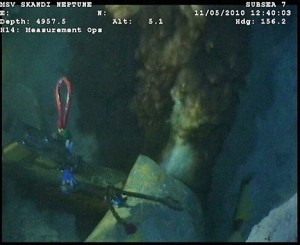Wayne Madsen
From environmentalists and wildlife specialists to fisherman and businessmen along the Gulf Coast the message is the same: BP is not only strangling the news of what is actually occurring in the Gulf of Mexico with the oil disaster but has co-opted key federal regulatory and oversight agencies to advance its agenda and that of its oil partners, including Halliburton, Anadarko, and Transocean.

Elmer's Island, in the Gulf Coast is becoming one of many BP's toxic dumps.
The logistics of the oil clean-up is being criticized because of the over-dependence on deepwater oil skimmer boats. No procedures are in place for using skimmers that can operate in shallower waters of 1 1/2 to 2 feet. There are a number of boats that could be used for shallow water skimming being tied up in port and not being used by BP.
Fishermen who have experience in rescuing sea turtles enmeshed in fishing nets are not being used in turtle rescue operations. In fact, they face arrest if they even touch an endangered turtle. Some 3,000 fisherman have remained idled by the oil disaster and most have not been hired by BP. Idled fishermen were told by BP that they would be called when their help was needed. However, later BP told them that many would probably never be called.
BP has hired an army of contractors and sub-contractors who are spending plenty of “flash money” to assuage some local businesses. However, WMR noticed while driving to Louisiana a large number of seafood distributors and restaurants that were shuttered.
Those hired by BP to clean up beaches and waters are not permitted to wear respirators and many are becoming sick, even coughing up blood. This editor, while driving to Venice, began to experience burning and watering eyes, a condition that lasted hours after returning to the west bank of New Orleans.
The disinformation being promulgated by BP is being accentuated by a number of local TV reporters being “embedded” with Coast Guard units in the waters off the coast and in the marshland and estuaries. Furthermore, the National Oceanic and Atmospheric Administration (NOAA), accused by many local environmentalists and fishermen of being complicit in the cover-up of bad news, has issued a report claiming that tests of 600 fish caught in waters “near the edge of the oil” have proven negative for chemical toxins. Fishermen interviewed by WMR said the claim is ludicrous since there are no fish in the waters in the oil zone or near it.
Gone from the waters of the Gulf off Louisiana are grouper, snapper, amberjack, tuna, and even the small colorful blenny, which normally feeds at oil rig pylons in the Gulf and is found only in the Amazon basin, in addition to the Louisiana Gulf waters. The Gulf waters are slowly being turned into a hydrocarbon soup of dispersed oil bubbles that is translucent black in color.
Fishing boat owners whose boats have been used for clean-up efforts are suffering fiberglass hull damage from hydrocarbon penetration and BP has informed the owners that their boats will have to be destroyed afterwards and their hulls ground up. However, even boats not being used for clean-up will be destroyed with no assurance that BP will compensate the owners.
NOAA is also reportedly sitting on bathymetric maps of the Gulf sea floor that shows a massive fissure on the sea floor that is located 7 miles from the Deepwater Horizon site. The fissure is leaking 120,000 gallons of crude a day, along with methane gas. The Corexit-dispersed oil has seeped under booms set up to protect Lake Ponchartrain, which lies north of New Orleans. Dead fish and tar balls have now turned up in the lake.
Further out in the Gulf and along sensitive refuges like Elmer’s Island, massive fish kills are being reported by local residents. The Coast Guard and BP have established a no-fly zone over Elmer’s Island, a major bird sanctuary.
In addition, local fishermen said that nurseries in the Gulf, responsible for producing 40 percent of America’s seafood, are being destroyed by the oil and the chemical soup created by the mixing of oil dispersant Corexit 9500. Corexit is breaking down the crude oil into small oil bubbles and a watery oil mixture that is seeping under the booms set up to protect sensitive fish nurseries, oyster beds, and other pristine areas. Many Atlantic fish species also spawn in the Gulf and they are also threatened by the oil disaster. Even barnacles, one of the most resistant sea creatures to extreme situations, are dying in vast numbers, along with sponges and coral.
Near Venice, Louisiana in Plaquemines Parish, is the old Civil War fort of Fort Jackson. A national historical site and park, Fort Jackson has been turned into a major base for joint BP-Coast Guard dumping of Corexit on oil in the Gulf. WMR witnessed five helicopters carrying suspended white bags of Corexit out over Gulf waters.
Hastily-erected signs at the entrances to Fort Jackson warn that the site is closed to visitors because of “construction.” Fort Jackson actually serves as a major base of operations for BP and Coast Guard activities. The Obama administration, which has stated its commitment to “open government,” is engaged in what amounts to semi-covert BP-Coast Guard operations in the Gulf.
WMR has also been informed by a reputable source that BP has been engaged in night time spraying of a bleaching agent on Louisiana beaches to make it appear that the beaches are being cleaned up. The planes, which fly at night, disregard flight regulations by flying with their lights out. The operations have been approved by the Coast Guard and Federal Aviation Administration (FAA).
Also coming in for criticism is the US Environmental Protection Agency (EPA), which has remained silent as federal incident commanders have ordered home wildlife rescue workers from Texas and other states. One group that was told to pack its bags was the non-profit Wildlife Rescue & Rehabilitation, Inc. from Texas, which has 20 years of experience in handling animal rescues from oil spills. BP hired the O’Brien Group, a subsidiary of SEACOR Holdings of Fort Lauderdale, Florida, as its wildlife rescue coordinator. Local environmentalists view O’Brien as a shill for BP.
The EPA is also remaining mute on air quality reports from Venice that show that on May 7 hydrogen sulfide in the air was measured at 1192 parts per billion. Five parts per billion is considered hazardous to human health. In addition, the May 7 reports show that benzene levels in the air were measured at 5000 parts per billion, again in the health danger zone. Propylene glycol, a major component in Corexit 9500, is being measured in Gulf waters at 150 times its lethal concentration.
BP has hired the same firm that performed air quality monitoring in the aftermath of hurricane Katrina’s Murphy oil spill in Chalmette to perform monitoring for the current oil disaster. The firm has been called a “proven liar” in both incidents by environmentalists and emergency planners.
BP clean-up workers have also been found dumping tar balls from the water and beaches in land-fills in Mississippi and St. Tammany Parish, Louisiana. The oil from the sludge is seeping into the local water tables.
The corporate news media, particularly the local New Orleans television stations, are embedding their reporters with Coast Guard and BP teams in the Gulf. The corporate media reports essentially serve as public relations outreeach for BP. A number of New Orleans and Louisiana groups are trying to get the actual news about the disaster out but face limited resources.
To call the Gulf oil disaster the worst environmental disaster in the history of the United States is an understatement. And with the connivance of the Obama White House, the Gulf of Mexico is being turned into the Gulf of Death.


 project, which involved trying to pump tens of thousands of gallons of mud, shredded rubber tires and other “junk” into the hole to try to halt the outflow of oil.
project, which involved trying to pump tens of thousands of gallons of mud, shredded rubber tires and other “junk” into the hole to try to halt the outflow of oil.
